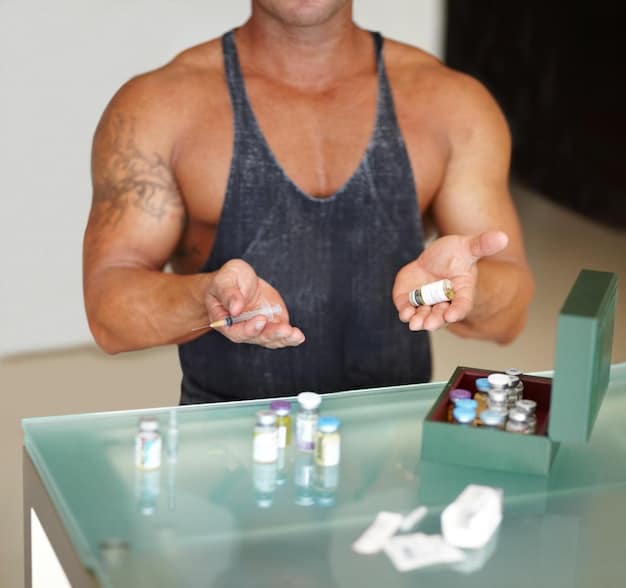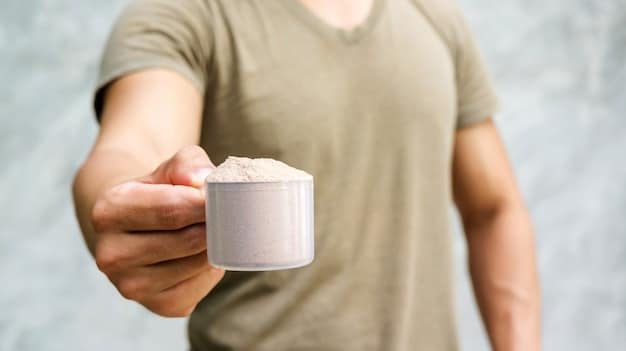Unlocking Muscle Growth: 2025 Creatine Guide for US Bodybuilders

Unlocking unparalleled muscle growth in 2025 necessitates a strategic approach to creatine supplementation, integrating advanced dosing protocols, personalized genetic considerations, and cycling methodologies for optimal performance and safety among US bodybuilders.
In the dynamic world of bodybuilding, the quest for enhanced muscle growth often leads to exploring cutting-edge strategies and supplements. Among these, creatine stands as a cornerstone, continually evolving in its application. This guide, Unlocking Muscle Growth: The 2025 Guide to Creatine Supplementation for US Bodybuilders, delves into the most current, science-backed approaches to maximizing your gains through this powerful compound.
Understanding Creatine: Beyond the Basics for 2025
Creatine, a naturally occurring compound found in muscle cells, plays a pivotal role in energy production during high-intensity, short-duration activities like weightlifting. Its fundamental benefit lies in regenerating adenosine triphosphate (ATP), the primary energy currency of the cell, allowing for more muscular work before fatigue sets in. However, the landscape of creatine supplementation has matured significantly, moving beyond simplistic dosing to a nuanced understanding of its physiological impacts and optimized utilization in 2025.
For US bodybuilders, this means appreciating creatine not just as a mass builder but as a multifaceted enhancer of strength, power, and even recovery. The emphasis has shifted from mere intake to strategic integration, considering individual responsiveness and specific training goals. The science now points towards personalized approaches rather than a one-size-fits-all model.
The Science of Creatine Action
At its core, creatine supplementation saturates muscle creatine stores, increasing the phosphocreatine pool. This expanded pool enables quicker ATP resynthesis, directly translating to more reps, heavier lifts, and extended high-intensity sets. This mechanism is what drives tangible improvements in gym performance, which, over time, translates into significant muscle hypertrophy.
- Enhanced ATP Regeneration: Fuels explosive movements and allows for sustained effort.
- Increased Cellular Hydration: Draws water into muscle cells, leading to a volumizing effect and potential direct anabolic signals.
- Reduced Muscle Damage and Inflammation: Supports faster recovery, facilitating more frequent and intense training sessions.
- Improved Glycogen Storage: Can enhance muscle glycogen replenishment, further aiding recovery and performance.
Creatine Forms and Efficacy in 2025
While creatine monohydrate remains the gold standard due to its extensive research backing and cost-effectiveness, the market continues to introduce various forms, each with anecdotal claims of superior absorption or reduced side effects. In 2025, while new formulations may emerge, the scientific consensus strongly supports monohydrate as the most effective and reliable option. Other forms such as creatine ethyl ester, creatine hydrochloride (HCl), or buffered creatine have not consistently shown superior benefits over monohydrate in controlled studies.
The key takeaway for US bodybuilders is to prioritize proven efficacy over marketing hype. Investing in high-quality, pure creatine monohydrate from reputable sources ensures you are getting the most for your investment. Certificates of analysis and third-party testing are crucial indicators of product quality in a saturated market.
The evolution of understanding creatine’s mechanism and forms underpins its continued relevance. For the bodybuilder aiming for optimal gains, a deep dive into these basic principles with a modern perspective is crucial to setting the stage for advanced supplementation strategies.
Advanced Creatine Dosing Protocols for Optimal Growth
Moving beyond the traditional “loading phase then maintenance” approach, 2025 sees a more sophisticated understanding of creatine dosing protocols for muscle growth. While the classic method remains effective, advanced strategies consider individual responses, genetic predispositions, and the nuances of training cycles. The goal is to maximize muscle creatine saturation while minimizing potential side effects and optimizing absorption.
Personalized Loading and Maintenance
The standard loading phase involves 20g/day for 5-7 days, followed by a maintenance dose of 3-5g/day. However, some bodybuilders find this aggressive loading leads to gastrointestinal discomfort or water retention. An alternative refined approach involves a slower loading phase of 10g/day for 10-14 days or even skipping the load entirely and simply initiating a consistent 3-5g/day dose. This slower saturation takes longer to reach peak muscle creatine levels but can be more comfortable for some individuals, particularly those sensitive to higher doses.
For maintenance, the 3-5g range is generally sufficient for most individuals. However, larger athletes or those with higher muscle mass might benefit from the upper end of this range, or even slightly more, up to 10g/day, especially during intense training periods. Monitoring your body’s response and performance metrics over time is paramount to finding your optimal maintenance dose.
- Standard Load: 20g/day for 5-7 days, then 3-5g/day.
- Slow Load: 10g/day for 10-14 days, then 3-5g/day.
- No Load: Begin directly with 3-5g/day for continuous saturation.
- Individualized Maintenance: 3-10g/day, depending on body size and training intensity.

Timing and Synergy: When and What to Mix Creatine With
The timing of creatine intake is often debated. While some research suggests post-workout intake with carbohydrates and protein for maximal absorption (due to insulin’s role in creatine uptake), the overall saturation of muscle creatine stores is more critical than precise timing. Consistency is key. Taking creatine daily, regardless of whether it’s a training day or a rest day, ensures continuous saturation.
However, synergistic compounds can enhance absorption or amplify effects. Combining creatine with a rapidly digesting carbohydrate source (like dextrose or fruit juice) and protein (e.g., in a post-workout shake) can facilitate insulin release, which aids in creatine transport into muscle cells. Additionally, some bodybuilders integrate creatine with other supplements to create a more comprehensive anabolic environment, such as beta-alanine for buffering lactic acid or BCAAs/EAAs for muscle protein synthesis.
The advanced protocols in 2025 emphasize a more intelligent, personalized approach to creatine dosing, moving away from rigid rules towards adaptable strategies that align with individual physiological responses and training demands. This thoughtful application is essential for unlocking creatine’s full potential in muscle development.
Creatine Cycling and Long-Term Strategies
The practice of creatine cycling – taking creatine for a period and then discontinuing it – has been a long-standing debate within the bodybuilding community. While there’s no universally agreed-upon consensus, 2025 sees a refined perspective on cycling, driven by both practical considerations and an evolving understanding of creatine’s long-term effects. This section explores the rationale behind cycling and alternative continuous strategies.
To Cycle or Not to Cycle: The Rationale
Historically, cycling was recommended to prevent potential receptor downregulation, side effects, or to “resensitize” the body to creatine’s effects. However, current scientific evidence largely suggests that the human body does not become “resistant” to creatine with prolonged use, nor is there significant evidence of receptor downregulation affecting its efficacy. Muscle creatine transporters continue to function effectively even with consistent long-term supplementation.
Despite this, some bodybuilders still opt for cycling for several reasons: perhaps to psychologically reset, to assess their baseline performance without supplementation, or due to personal preference and anecdotal experience. A typical cycling protocol might involve 8-12 weeks of supplementation followed by 2-4 weeks off. During the “off” period, muscle creatine stores will gradually deplete, returning to baseline over several weeks.
- Psychological Reset: Allows athletes to mentally break from supplementation.
- Baseline Assessment: Helps individuals understand their natural performance without creatine.
- Cost Efficiency: Can reduce overall supplement expenditure over time.
- Anecdotal Preference: Some feel better or believe they experience renewed effects after a break.
Long-Term Continuous Supplementation
The prevailing scientific view, and increasingly the common practice in 2025, supports long-term, continuous creatine supplementation. Numerous studies have demonstrated the safety and efficacy of continuous use for years, with no significant adverse health effects reported in healthy individuals adhering to recommended dosages. For a bodybuilder, the benefit of continuous muscle creatine saturation means consistent maximal performance in the gym, which directly translates to sustained progress in muscle growth.
The argument for continuous use is compelling: why intentionally reduce a performance advantage if it’s safe to maintain? For those aiming for consistent, incremental gains, interrupting creatine intake means temporarily reducing muscular power and delaying adaptations that rely on peak ATP regeneration.
Monitoring and Adjusting
Whether you choose to cycle or not, careful monitoring of your body’s response is key. Note changes in strength, recovery, and body composition. If you decide to cycle, pay attention to how your performance is affected during the “off” period and how quickly you resaturate upon restarting. For long-term continuous users, simple adherence to quality products and recommended dosages is the primary strategy.
The discussion around creatine cycling has matured into a more nuanced understanding, where the individual’s goals, comfort, and existing evidence base guide practical application. For the competitive US bodybuilder, maximizing consistent performance often steers them towards continuous, safe supplementation, leveraging creatine’s benefits without interruption.
Creatine and Body Composition: Beyond Just Mass
While creatine is renowned for its role in increasing muscle mass, its impact on body composition goes beyond simple weight gain. In 2025, bodybuilders are increasingly recognizing creatine’s multifaceted effects on fat loss, muscle definition, and overall physique aesthetics. Understanding these broader implications provides a more holistic view of creatine’s value in a recomp or cutting phase, not just during bulking.
Water Retention and Muscle Volumization
One of the most immediate effects of creatine supplementation is increased intracellular water retention. Creatine draws water into muscle cells, leading to a volumized appearance. This is distinct from subcutaneous water retention (under the skin), which can obscure muscle definition. The intracellular water acts as an anabolic signal, potentially stimulating protein synthesis and reducing protein breakdown, contributing to muscle growth.
This cellular hydration can lead to an initial weight gain upon starting creatine, often mistakenly attributed to fat gain. However, this is muscle-specific water, which visually enhances muscle fullness and can improve the “pump” during workouts. For bodybuilders, a fuller, more rounded muscle belly is highly desirable, contributing to a more impressive physique both on and off stage.
Creatine’s Indirect Role in Fat Loss
While creatine doesn’t directly burn fat, its contribution to fat loss is significant through indirect mechanisms. By increasing strength and power, creatine allows for higher intensity and volume in resistance training. More intense workouts equate to greater energy expenditure and a higher metabolic rate, both during and after exercise. This heightened metabolic demand, coupled with increased muscle mass (which is metabolically active tissue), helps to burn more calories daily, aiding in fat reduction.
Furthermore, maintaining strength and muscle mass during a caloric deficit is crucial for successful cutting phases. Creatine helps preserve performance, allowing bodybuilders to lift heavy even when calories are restricted, thereby signaling to the body to retain muscle tissue rather than break it down for energy. This muscle-sparing effect is invaluable for achieving a lean, defined physique.
- Enhanced Training Intensity: Allows for more calories burned during workouts.
- Increased Muscle Mass: Raises basal metabolic rate, burning more calories at rest.
- Muscle Preservation: Helps maintain strength and lean mass during caloric deficits.
- Improved Recovery: Facilitates consistency in training, crucial for energy balance.

Optimizing Creatine for Aesthetics
For bodybuilders, aesthetics are paramount. Creatine contributes to this by promoting muscle fullness and facilitating intense training sessions that carve out definition. When combined with proper nutrition and training, creatine supports the creation of a physique that is not only larger but also more aesthetically pleasing, with distinct muscle separation and vascularity, particularly during a cutting phase where every ounce of preserved muscle detail counts.
The recognition of creatine’s broad impact on body composition—from direct muscle volumization to indirect fat loss support—solidifies its position as an essential supplement for US bodybuilders pursuing not just mass, but a complete, optimized physique in 2025.
Creatine and Special Populations: Considerations for US Bodybuilders
While creatine is widely recognized as safe and effective for the general healthy population, its use within specific bodybuilder demographics—such as younger athletes, older individuals, or those with unique physiological considerations—warrants careful attention. In 2025, a nuanced approach ensures that all US bodybuilders can safely leverage creatine’s benefits while acknowledging individual variations.
Younger Bodybuilders (Under 18)
The use of creatine in adolescents is a topic of ongoing discussion. Most scientific bodies, including the American Academy of Pediatrics, generally do not recommend performance-enhancing supplements for individuals under 18 due to concerns about potential long-term effects on developing organ systems and the prioritization of fundamental training and nutrition. However, a growing body of research involving adolescent athletes suggests that creatine, when used at recommended dosages and under parental/medical supervision, appears safe and effective, particularly for those engaged in intense, structured athletic training.
For US bodybuilders under 18, the emphasis should always be on acquiring a strong foundation through proper nutrition, adequate rest, and consistent training before considering supplementation. If creatine is considered, it must be in consultation with a physician or a qualified sports nutritionist who can assess individual needs and monitor for any adverse effects. Education on responsible use and the avoidance of excessive dosing is crucial.
Older Bodybuilders (Over 40)
Creatine actually shows significant promise and even greater relevance for older bodybuilders. As individuals age, they experience sarcopenia—the natural, progressive loss of muscle mass and strength. Creatine supplementation can effectively combat this. By increasing strength and power, it enables older adults to maintain higher intensity in resistance training, which is critical for preserving muscle mass and bone density.
Furthermore, creatine may offer additional benefits in older populations, including improved cognitive function and neuroprotection, aspects that become increasingly important with age. For the seasoned US bodybuilder, creatine can be a key tool in maintaining a competitive edge, enhancing quality of life, and mitigating age-related decline in muscle function. Dosing protocols typically remain similar to younger adults, but good hydration practices are even more critical.
Health Considerations for All Bodybuilders
Regardless of age, any bodybuilder considering creatine should consult with their healthcare provider, especially if they have pre-existing medical conditions. While creatine is generally very safe for healthy kidneys, individuals with kidney dysfunction or conditions affecting kidney health should exercise extreme caution and seek medical advice before use. Hydration is key for all creatine users, but particularly important for those with any renal concerns.
Creatine’s interaction with medications is generally minimal, but it is always wise to discuss your supplement regimen with your doctor. Being transparent about all supplements you are taking ensures that your physician can provide the most appropriate and safe guidance, tailored to your unique physiological profile. This proactive approach ensures safe and effective creatine supplementation for all US bodybuilders in 2025.
Addressing Common Myths and Misconceptions in 2025
Despite decades of extensive research supporting creatine’s safety and efficacy, several persistent myths and misconceptions continue to circulate within the fitness community. In 2025, it’s crucial for US bodybuilders to distinguish scientific fact from anecdotal folklore to make informed decisions about their supplementation strategy. Dispelling these myths ensures safe and effective use of creatine for optimal muscle growth.
Myth 1: Creatine Causes Kidney Damage
This is arguably the most common and persistent myth. Numerous comprehensive, long-term studies have consistently demonstrated that creatine supplementation, at recommended dosages, does not cause kidney damage or impair kidney function in healthy individuals. The misconception likely stems from the fact that creatine is metabolized into creatinine, a waste product that is filtered by the kidneys and used as an indicator of kidney function. However, elevated creatinine levels due to creatine supplementation reflect increased production, not necessarily impaired kidney function. For individuals with pre-existing kidney disease, caution is always advised, and medical consultation is essential.
- No Causal Link: Research consistently refutes a link between creatine and kidney damage in healthy individuals.
- Creatinine Levels: Elevated creatinine is a byproduct, not an indicator of renal failure in creatine users.
- Medical Consultation: Essential for individuals with pre-existing kidney conditions.
Myth 2: Creatine Causes Dehydration and Cramping
Another widespread concern is that creatine leads to dehydration and muscle cramps, particularly in hot environments. The opposite is generally true. Creatine draws water into muscle cells (intracellular hydration), which helps maintain cellular fluid balance. Studies have shown that creatine users may actually have a lower incidence of cramping and dehydration, especially in athletes training in heat. Adequate fluid intake is always important for any athlete, but creatine itself does not inherently cause dehydration or cramping.
Myth 3: Creatine is an Anabolic Steroid or Illegal Substance
Creatine is a naturally occurring compound found in muscle cells and is widely available and legal in sports. It is not an anabolic steroid and does not work by mimicking hormones. Its mechanism of action involves enhancing energy production within muscle cells. It is recognized and permitted by virtually all major sports organizations, including the NCAA, IOC, and WADA, due to its natural occurrence and non-hormonal action.
Myth 4: Creatine is Only for Men or Only for Bulking
Creatine is equally effective and beneficial for women, aiding in strength, muscle growth, and cognitive function without causing masculinizing effects. Its benefits are universal across genders for anyone engaged in high-intensity exercise. Likewise, while its benefits are evident during bulking phases, its muscle-sparing effects and ability to maintain strength during caloric deficits make it highly valuable for cutting and body recomposition as well. Its utility extends beyond simple mass gain to overall athletic performance and physique development.
By debunking these entrenched myths, US bodybuilders in 2025 can approach creatine supplementation with confidence, relying on established scientific evidence rather than outdated information. This clarity is paramount for safe, effective, and optimized muscle growth strategies.
The Future of Creatine Supplementation: Emerging Trends 2025
As we advance into 2025, the research and application of creatine supplementation continue to evolve, hinting at exciting trends that could further optimize its use for US bodybuilders. While creatine monohydrate remains the cornerstone, new delivery systems, synergistic stacks, and a deeper understanding of individual responsiveness are shaping the future landscape.
Optimized Delivery Systems and Bioavailability
While various forms of creatine beyond monohydrate have largely failed to demonstrate superior efficacy, research is exploring novel delivery systems that could enhance bioavailability or reduce individual gastrointestinal discomfort. This might include microencapsulated forms, improved solubility formulations, or even more targeted delivery mechanisms. The aim isn’t necessarily a “more potent” creatine, but rather one that is absorbed more efficiently or with fewer digestive issues for sensitive individuals. However, strict scientific vetting will be crucial to differentiate genuine advancements from marketing gimmicks.
Another area of interest is the potential for personalized supplement combinations based on genetic profiles. While still in its infancy, pharmacogenomics could one day inform which individuals might benefit more from creatine, or how their unique metabolic pathways respond to certain co-ingestions. This level of personalization, however, is likely several years away from widespread practical application for most bodybuilders.
Synergistic Stacks and Nootropic Applications
The trend of combining creatine with other evidence-based supplements to create synergistic effects is likely to intensify. Beyond basic carbohydrates and protein, research into combining creatine with specific amino acids (like L-carnitine or betaine), adaptogens, or even specific vitamins and minerals to optimize cellular energy pathways is gaining traction. The goal is to maximize performance not just through direct ATP regeneration, but by supporting all facets of muscle growth and recovery holistically.





